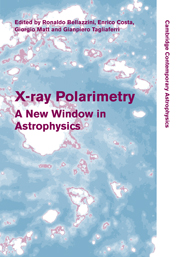Book contents
- Frontmatter
- Contents
- List of contributors
- Preface
- 1 X-ray polarimetry: historical remarks and other considerations
- Part I Polarimetry techniques
- Part II Polarized emission in X-ray sources
- Part III Future missions
- 37 Gravity and Extreme Magnetism SMEX (GEMS)
- 38 Programs of X-ray polarimetry in Italy
- 39 A polarimeter for IXO
- 40 Polarimetry with ASTRO-H soft gamma-ray detector
- 41 The Energetic X-ray Imaging Survey Telescope and its polarization sensitivity
- 42 PoGOLite: a balloon-borne soft gamma-ray polarimeter
- 43 Studies of neutron background rejection in the PoGOLite polarimeter
- 44 Observing polarized X-rays with PoGOLite
- 45 Pre-flight qualification tests of the PoGOLite detector system
- 46 The Gamma-RAy Polarimeter Experiment (GRAPE) balloon payload
- 47 POLAR: an instrument dedicated to GRB polarization measurement
- 48 Polarization detection capability of GRIPS
- 49 X-ray and γ-ray polarimetry small-satellite mission PolariS
- 50 GAP aboard the solar-powered sail mission
- 51 Hard X-ray polarimeter for small-satellite missions
- 52 Performance of hard X-ray polarimeter: PHENEX
- 53 GRB polarimetry with POET
- Author index
- Subject index
46 - The Gamma-RAy Polarimeter Experiment (GRAPE) balloon payload
from Part III - Future missions
Published online by Cambridge University Press: 06 July 2010
- Frontmatter
- Contents
- List of contributors
- Preface
- 1 X-ray polarimetry: historical remarks and other considerations
- Part I Polarimetry techniques
- Part II Polarized emission in X-ray sources
- Part III Future missions
- 37 Gravity and Extreme Magnetism SMEX (GEMS)
- 38 Programs of X-ray polarimetry in Italy
- 39 A polarimeter for IXO
- 40 Polarimetry with ASTRO-H soft gamma-ray detector
- 41 The Energetic X-ray Imaging Survey Telescope and its polarization sensitivity
- 42 PoGOLite: a balloon-borne soft gamma-ray polarimeter
- 43 Studies of neutron background rejection in the PoGOLite polarimeter
- 44 Observing polarized X-rays with PoGOLite
- 45 Pre-flight qualification tests of the PoGOLite detector system
- 46 The Gamma-RAy Polarimeter Experiment (GRAPE) balloon payload
- 47 POLAR: an instrument dedicated to GRB polarization measurement
- 48 Polarization detection capability of GRIPS
- 49 X-ray and γ-ray polarimetry small-satellite mission PolariS
- 50 GAP aboard the solar-powered sail mission
- 51 Hard X-ray polarimeter for small-satellite missions
- 52 Performance of hard X-ray polarimeter: PHENEX
- 53 GRB polarimetry with POET
- Author index
- Subject index
Summary
The Gamma-RAy Polarimeter Experiment (GRAPE) is a concept for an astronomical, hard X-ray, Compton polarimeter operating in the 50–500 keV energy band. The instrument has been optimized for wide-field polarization measurements of transient outbursts from energetic astrophysical objects such as gamma-ray bursts and solar flares. The GRAPE instrument is composed of identical modules, each of which consists of an array of scintillator elements read out by a multi-anode photomultiplier tube (MAPMT). Incident photons Compton-scatter in plastic scintillator elements and are subsequently absorbed in inorganic scintillator elements; a net polarization signal is revealed by a characteristic asymmetry in the azimuthal scattering angles. We have constructed a prototype GRAPE module, containing a single CsI(Na) calorimeter element, which has been calibrated using a polarized hard X-ray beam and flown on an engineering balloon test flight. A full-scale scientific balloon payload, consisting of up to 36 modules, is currently under development. The first flight, a one-day flight scheduled for 2011, will verify the expected scientific performance with a pointed observation of the Crab Nebula. We will then propose long-duration balloon flights to observe gamma-ray bursts and solar flares.
Introduction
The Gamma-RAy Polarimeter Experiment (GRAPE) is a scintillator-based Compton polarimeter designed to observe polarized astrophysical phenomena in the hard X-ray energy band (50–500 keV). Although intended primarily for observations of bright, transient events such as gamma-ray bursts (GRBs) and solar flares, GRAPE may also be operated in a collimated, pointed mode.
- Type
- Chapter
- Information
- X-ray PolarimetryA New Window in Astrophysics, pp. 314 - 321Publisher: Cambridge University PressPrint publication year: 2010
- 3
- Cited by



